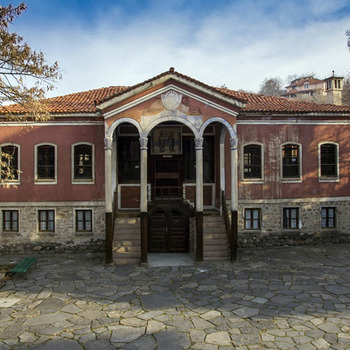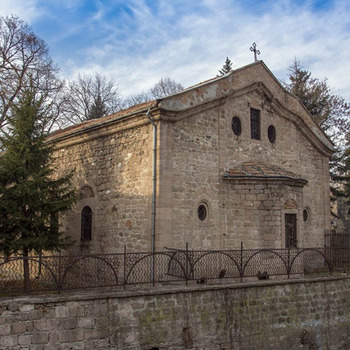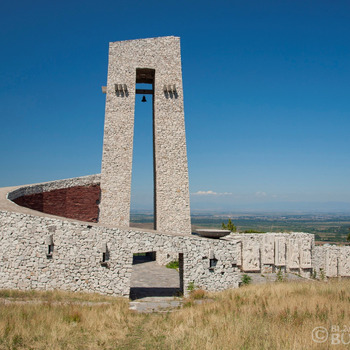Early Christian Basilica Red Church
Overview
The Red Church is one of the masterpieces of early Christian architecture in Europe, it is an architectural and archaeological monument of national importance. It received a status of a national ancient monument in 1927, and an architectural monument in a ruinous appearance - in 1966.
During the period 2010-2013, a project was implemented for strengthening, conservation, access and socialization of the archaeological site. A road connection was made, a reception building was added and the surrounding area is well-developed, consistent with the requirements for an accessible structure for people with disabilities. After the reconstruction, pedestrian access to the church was formed as well as a panoramic alley, an approach for the disabled and an information center. The repairs of the church consist of its strengthening and removing of the old wooden support structure and placing a new metal one. The very walls of the church are preserved and, where more shaping was needed the volumes were made anew. Artistic lighting was also added that illuminates the object in the night.
Early Christian basilica, The Red Church is located 2 km northeast of Perushtitsa. The beginning of early settlement life is determined to be around the VI century BC. A prehistoric settlement was found 500 meters from the church. Nearby there is evidence of another settlement in the area Djakovica, as it dates back to the IV century BC.
The Red Church was built in the early middle ages - V - VI century BC. The central building takes the shape of a four-leafed clover and placed on the remains of another building with a similar plan. The remains form the main part of the church and include a four corner space, including two bypass corridors which are located around the northern and southern conch. Subsequently more rooms where added: a double narthex, a chapel adjoined to it from the south side and a baptistery (baptismal) from the north side. The portico with columns from the west shapeentrance of the church. The approach to the last entrance is a stone staircase, from which only individual rocks where preserved. The overall dimensions of the church are: length - 32.45 m and width - 29 meters.
The first known source, which mentions the church is Steward Constantine in 1819, which defines it as a "ruin". Information about it is also shared by Constantine Irechek. In 1915 The Bulgarian Archaeological Society undertook a study, which was interrupted by the First World War. During that time Feodor Schmidt photographs the parts which are visible above ground.
In 1921, regular archeological researches where initiated by the Bulgarian Archaeological Institute, assisted by Thomas Whitmore. During the excavations, a complete capture of the monument was carried out by Sergei Pokrovsky. Color copies of the murals where made by Olga Vivdenko-Belokopitova (currently housed in the Byzantine library, College de France, Paris) and by M. Georgiev (stored in the archives of the NAIM-BAN). Two fragments were removed from the walls and placed in the National Archaeological Museum. The findings from the excavations where published by Andrey Frolov. He also fits in his study copies of Pokrovsky’s drawings. A similar research of the murals was made by André Grabar. The church has also been repeatedly mentioned in other historical researches like Bogdan Filov Nicolas Mavrodinov, Krystju Miyatev, Vera Ivanova, Sava Bobchev Margarita Vaklinova, M.Tsapenko Nelly Chaneva, Hristo Danov.
Another detailed study was carried out in 1956 by Dora Panayotova which undertook the task of summarizing the findings so far and to make an accurate reconstruction and dating, accompanied by rich illustration material. A series of publications with similar research and studies, made on the spot, was made by Stefan Boyadzhie, which complete and develop the historical and architectural analysis of the church. The most recent archaeological excavations, are also reflected in various publications by Margarita Vaklinova.
The dating of the "Red Church" based on its architecture, murals, archaeological and historical data suggests the following periods of its existence:
- Construction of the original building - around the middle or end of the IV century, which was probably destroyed during the reign of Julian the Apostate (years 361-363);
- Rebuilding of the martyr, adding a narthex and an outer narthex in / double narthex, separated by columns / construction of the chapel and later baptistery.
- In the end of the IV up to the end of the V century, according to different authors, the occurrence of parabeni(two opposite premises) appeared next to the altar - related to the rule of Justinian during the second half of the VI century, as well as the end of the V century, to the beginning of the VI century, the church was decorated with rich early Byzantine wall decorations.
- At the end of the VI century and the beginning of the VII century invasions by the Slavs and Avars take place, during this period the church was seriously damaged, as evidenced by traces of fire and destruction.
- Recovery becomes likely in the XI century, a portico at the west entrance was added, the bypass corridors where not used, parts of the wall around the monument where rebuild, a necropolis was added as part of the graves are above the level of the bypass corridors, latter other buildings where build around the church. From that period new murals where added to the walls. In this form the temple has survived up to the beginning of the XIII century.
When analyzing the Red Church, researchers make analogies to other buildings with similar composition plans - Stoa of Adrian in Athens, the ancient mausoleums in the church "St. Sofia "in Edirne, the Martirio in Rusafa. At the same time a comparison to the construction, references to two other churches in Bulgaria – Basilica “Elena” next to Pirdop and basilica "St. Sofia” in Sofia.
Recommended
- Museum of History
- Chapel of St. Petka
- Monument to the three generations
- Ustinski waterfall


 Bulgarian
Bulgarian Romanian
Romanian






